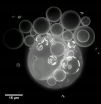(Press-News.org) Case Western Reserve University mental health researcher Joseph Galanek spent a cumulative nine months in an Oregon maximum-security prison to learn first-hand how the prison manages inmates with mental illness.
What he found, through 430 hours of prison observations and interviews, is that inmates were treated humanely and security was better managed when cell block officers were trained to identify symptoms of mental illness and how to respond to them.
In the 150-year-old prison, he discovered officers used their authority with flexibility and discretion within the rigid prison structure to deal with mentally ill inmates.
Galanek's observations and interviews with 23 staff members and 20 inmates with severe mental illness, are described in the Medical Anthropology Quarterly article, "Correctional Officers and the Incarcerated Mentally Ill: Responses to Psychiatric Illness in Prison." The National Science Foundation and the National Institute of Mental Health supported his research.
"With this research, I hope to establish that prisons, with appropriate policies and staff training, can address the mental health needs of prisoners with severe mental illness," said Galanek, PhD, MPH a medical anthropologist and research associate at the Jack, Joseph and Morton Mandel School of Applied Social Sciences' Begun Center for Violence Education and Prevention Research at Case Western Reserve.
"Additionally," he said, "I show that supporting the mental health needs of inmates with severe mental illness concurrently supports the safety and security of prisons, and that these two missions are not mutually exclusive. With the number of prisoners with severe mental illness in prison increasing, efforts need to be made by all prison staff to ensure that this segment of the prison population has appropriate mental health care and safety."
Galanek saw how administrative policies and cultural values at the prison allowed positive relationships to develop between officers and prisoners diagnosed with severe mental illnesses, among the prison's 2,000 inmates.
In this maximum-security prison, left unidentified for the study to protect the confidentiality of officers and inmates, officers received training to identify symptoms of mental illness, which, in turn, led to better security, safety and humane treatment of potentially volatile inmates. But the officers were also able to use their discretion in handling some situations.
Galanek observed, for example, the following instances where an officer's decision—rather than rigidly enforcing prison rules—helped mentally ill inmates and maintain order within the institution:
Prisoners are required to work 40 hours at an assigned job. But one inmate chose to remain in his cell instead of reporting to work—a prison offense. The inmate told the officer he was experiencing auditory hallucinations. Instead of sending the prisoner to a disciplinary unit, the officer allowed the prisoner to remain in his cell until the hallucinations passed.
A correctional officer confronted a violent prisoner, who was off his medication and began smashing a TV and mirror and threatened other prisoners. Instead of disciplinary confinement, the officer conferred with mental health workers, who sent the prisoner to the inpatient psychiatric unit to get him back on his medication.
Prisoners aren't allowed to loiter or talk to other inmates outside their cells. But a high-functioning inmate with a bipolar disorder worked a janitorial job that allowed him to talk to other mentally ill inmates. Through those conversations, he was able to let officers know when inmates were exhibiting symptoms of their mental illness. That information allowed the officers to quickly address potential problems and decrease security risks.
Conversely, Galanek said, if these inmates were sent to the segregation unit ("the hole") to sit isolated for hours, their thoughts could lead to agitation and hallucinations that often bring on prison security problems. Mentally ill prisoners' work was important and meaningful because it acted as a coping mechanism to decrease the impact of psychiatric symptoms, he said.
To gain such access to prison culture is highly unusual. In fact, such ethnographic studies have declined in past 30 years due to perceptions that researchers are seen as security risks within these highly controlled environments. But as a mental health specialist in Oregon's Department of Corrections from 1996-2003, Galanek was uniquely prepared to navigate the prison for his research.
"They trusted me," he said. "I knew how to move, talk and interact with staff and inmates in the prison."
INFORMATION: END
CWRU researcher finds training officers about mental illness benefits prison's safety
2014-10-27
ELSE PRESS RELEASES FROM THIS DATE:
Starting salaries largely stagnant; internship scene improves
2014-10-27
EAST LANSING, Mich. --- The job market for new college graduates may be heating up fast, but starting salaries will see only modest growth, a Michigan State University economist says in a new study.
About six in 10 employers say they will keep starting pay the same as last year for newly minted degree-holders. The remainder will offer salary increases, on average, of a modest 3 percent to 5 percent, said Phil Gardner, author of Recruiting Trends, the nation's largest survey of employers' hiring intentions for college graduates.
"Pressure on employers to increase starting ...
Adverse drug reactions in children following use of asthma medications
2014-10-27
Since 2007, the European Medicines Agency (EMA), an EU agency, has gathered information on patients' experiences with adverse drug reactions (ADRs) in the European ADR database, EudraVigilance. Both authorities and pharmaceutical companies have a duty to report information about ADRs to the database, which provides new knowledge about unknown and serious ADRs:
"We have studied all EU adverse drug reaction reports on asthma medications approved for – and used by – children over a five-year period (2007 to 2011). In the light of the total use of asthma medications, ...
Study: Menopausal symptoms may be lessened with young children in the house
2014-10-27
BLOOMINGTON, Ind. -- A new study by researchers at The Kinsey Institute and the Fred Hutchinson Cancer Research Center has found that the timeless, multicultural tradition of grandmothering might have an unexpected benefit: helping some women temper their hot flashes and night sweats during menopause.
The researchers, two clinicians and a bioanthropologist, examined how close relationships can help women in midlife with this inevitable change -- with the clinicians looking for therapeutic benefits that might help patients deal with this unpredictable, poorly understood ...
Breakthrough in molecular electronics paves the way for DNA-based computer circuits in the future
2014-10-27
In a paper published today in Nature Nanotechnology, an international group of scientists announced the most significant breakthrough in a decade toward developing DNA-based electrical circuits.
The central technological revolution of the 20th century was the development of computers, leading to the communication and Internet era. The main measure of this evolution is miniaturization: making our machines smaller. A computer with the memory of the average laptop today was the size of a tennis court in the 1970s. Yet while scientists made great strides in reducing of the ...
Cell membranes self-assemble
2014-10-27
A self-driven reaction can assemble phospholipid membranes like those that enclose cells, a team of chemists at the University of California, San Diego, reports in Angewandte Chemie.
All living cells use membranes to define physical boundaries and control the movement of biomolecules, and movement of molecules through membranes is a primary means of sending signals to and from cells.
Neal Devaraj, a chemistry and biochemistry professor at UC San Diego, leads a research team that develops and explores new reactions that can trigger the formation of membranes, particularly ...
First time-lapse images of exploding fireball from a 'nova' star
2014-10-27
Astronomers at the University of Sydney are part of a team that has taken images of the thermonuclear fireball from a 'nova star' for the first time tracking the explosion as it expands.
The research is published in the journal Nature today.
The eruption occurred last year in the constellation of Delphinus (the Dolphin).
Professor Peter Tuthill, from the University's Sydney Institute for Astronomy and co-author on the paper says astronomers are excited about the achievement:
"Although novae often play second fiddle in the popular imagination to their more famous ...
Tremendously bright pulsar may be 1 of many
2014-10-27
Recently, a team of astronomers reported discovering a pulsating star that appears to shine with the energy of 10 million suns. The find, which was announced in Nature, is the brightest pulsar – a type of rotating neutron star that emits a bright beam of energy that regularly sweeps past Earth like a lighthouse beam – ever seen. But what are the odds finding another one?
According to one of the paper's authors, chances are good now that they know what to look for.
Professor Deepto Chakrabarty of the Kavli Institute for Astrophysics and Space Research at ...
Emergent behavior lets bubbles 'sense' environment
2014-10-27
VIDEO:
A collection of artificial lipid bubbles cycle through changes in their membranes as the surrounding environment changes. As the osmotic potential changes, different lipids in the membranes form patchy domains...
Click here for more information.
Tiny, soapy bubbles can reorganize their membranes to let material flow in and out in response to the surrounding environment, according to new work carried out in an international collaboration by biomedical engineers at the ...
One drop will do: UBC researchers develop simple new test for vitamin B12 deficiency
2014-10-27
Researchers at the University of British Columbia have developed a novel method to test for vitamin B12 deficiency that is sensitive enough to work on anyone, including newborn babies and large swaths of the general population.
Vitamin B12 deficiency can be tested with a single drop of blood collected from a finger prick, then blotted and dried overnight on a card consisting of filter paper. The UBC study made dried blood spot card analysis sensitive enough to measure the amount of methylmalonic acid (MMA), an indicator of a person's B12 level.
"This minimally invasive ...
International research group publishes updated criteria for diagnosing multiple myeloma
2014-10-27
ROCHESTER, Minn. –The International Myeloma Working Group (IMWG) today announced that it has updated the criteria for diagnosing multiple myeloma. A paper outlining the new criteria was published in the journal Lancet Oncology. Multiple myeloma is a blood cancer that forms in a type of white blood cell called a plasma cell.
"Our group, which includes more than 180 myeloma researchers worldwide, has updated the definition of multiple myeloma for diagnostic purposes to include validated biomarkers in addition to the current clinical symptoms used for diagnosis which ...



